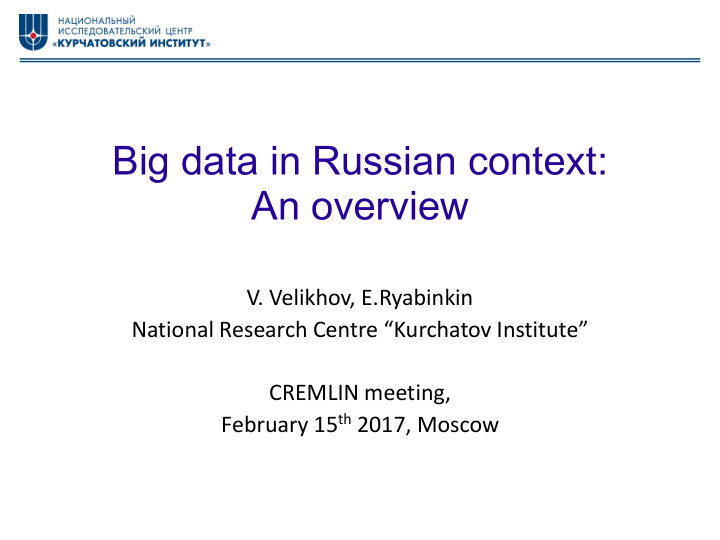



Big data in Russian context: An overview V. Velikhov, E.Ryabinkin National Research Centre “Kurchatov Institute” CREMLIN meeting, February 15 th 2017, Moscow
Research areas (NRC KI) Current Big Data providers: 1 HEP LHC (WLCG – RDIG) 2 Materials science (Nano – Bio) Synchrotron source Neutron source E Microscopy 3 Genomics 4 Brain science
Mega-science THE PARTICIPATION IN INTERNATIONAL PROJECTS ABROAD LHC European Organization for Nuclear Research (Geneva, Switzerland) European X-Ray Free Electron Laser (Hamburg, Germany) International Thermonuclear Experimental Reactor (Cadarache, France) Facility for Antiproton and Ion Research in Europe (Darmstadt, Germany) European Synchrotron Radiation Facility (Grenoble, France) PROJECTS ON ESTABLISHMENT OF MEGA SCIENCE FACILITIES WITH THE INTERNATIONAL PARTICIPATION ON TERRITORY OF THE RUSSIAN FEDERATION International Center for Neutron Research based on reactor PIK (Gatchina, Leningrad Region) Russian-Italian Project of Tokamak IGNITOR (Troitsk, Moscow) Specialized Synchrotron Radiation Source of the 4th Generation NICA (Nuclotron-based Ion Collider facility) complex (Dubna, Moscow Region)
e-infrastructure projects EGEE: took part in all three of them, as the part of the RDIG distributed Tier-2 infrastructure EGI: continuing to act within RDIG, new Tier-1 emerged, so coordination roles expanded Grid: not just a resource provider, also security coordination, operations and research (taking part in EGI CSIRT), national Certification Authority for Grid, regional monitoring, operations GLORIAD: KI led the RU part for the whole project duration RDIG : part of WLCG
e-infrastructure evolution Data Exchange Distributed Data management Data Analysis & Visualization Modelling & Simulation AA Both Grid/HTC (since 2003) and HPC (since 2007) HTC/HPC at our facilities already converge for some projects (when it is useful, e.g. for LHC and genomics) X.509 in the Grid and infrastructure; distributed LDAP used for HPC/cloud users with foreseen expansion to all KI sub- institutions
Tier1
HPC 4&5
Tier1 6300 TB DISC ТБ 7400 TB TAPE 71 000 COMP (HEP-SPEC06)
Networking Historically KI is good here: first connection between RU and Internet done from here via Finland Runs LHCONE backbone VRF for RU: connects all major Tier- 1/Tier-2, peers with most of other VRFs We provide general IP and R&E connectivity for all KI sub- institutions: ITEP, PNPI and IHEP (with new ones coming), over 10 Gbit/sec (and growing) of transit traffic Network presence at Amsterdam, Budapest, Finland Aggregated channel capacity to the rest of the world: 60 Gbit/sec
10/98
Infrastructure development Looking at ways to improve our infrastructure for the current and foreseen tasks Workbench approach for synchrotron-like use-cases Current research for LHC, Run-3 timeline: developing new approach for building Tier-1/Tier-2 (distributed) facilities Current research for 2019-2020: next-generation HPC which includes new interconnects (Omni-Path, photonics), liquid cooling, large SSDs (3D NAND & Co), convergence of GPGPU and x86 (Intel MIC), new FPGA and ARMs, dense (watt/rack) packaging
Technologies we use/extend CERN EOS and dCache: both as parts of a production in Tier-1 and R&D activity for federated cloud + WLCG/XFEL demonstrators, also CERNbox/EOS as KI infrastructure project Job management/scheduling: Torque/Maui, Slurm, CREAM CE, ARC CE Storage: Lustre, UFS/ZFS-based NFS, CERN VM FS, HTTP/Rsync/SSH-based access Management: HP CMU, CFEngine, Puppet, own deployment engine Pipeline engines: for some end-user activity Analysis : ANN & ML algorithms
Thank You!
Recommend
More recommend